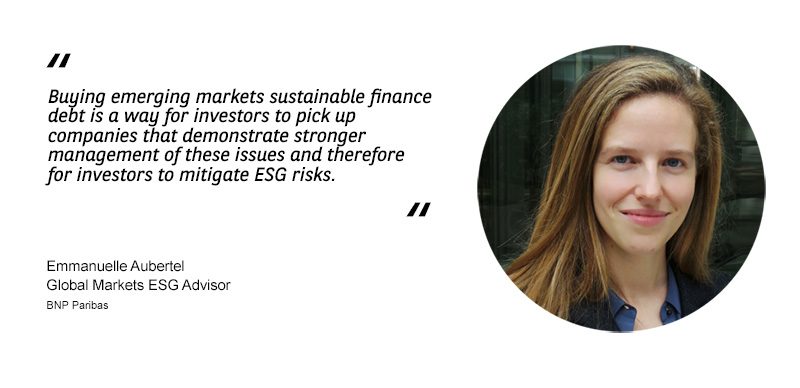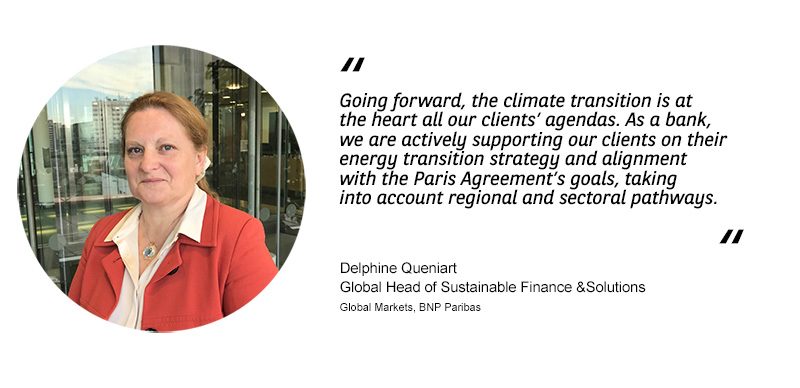A diverse marketplace
Sustainable debt issuance globally experienced exponential growth in 2020, expanding by 29% to reach a record $732 billion. Out of that total, emerging markets only accounted for around $30 billion: “It is still early days in the ESG journey for emerging markets,” said Agnes Gourc, head of sustainable capital markets at BNP Paribas, “Although activity has been gradually increasing”.LATAM sustainability capital markets diversify
Trevor Allen, Sustainability research analyst at BNP Paribas, adds that social bonds are becoming more prevalent in emerging markets, creating a diversity in the types of instrument available.| Mercado Libre, a leading Latin America (LATAM) fintech and ecommerce platform, issued a $1.1 billion dual tranche of sustainability notes designed to contribute to environmental objectives such as clean transport, land conservation and preservation, energy efficiency, renewable energy, green buildings; and pollution prevention. As Mercado Libre’s advisor in sustainable finance, BNP Paribas guided the company from the initial inception of the ESG tranche, assisting in the structuring of the framework, attaining the Second Party Opinion and attracting a number of ESG accounts from every continent, many of which would otherwise not have looked at emerging markets or a high-yield issuer. |
“Although green bonds account for the majority of sustainable debt in emerging markets, Covid-19 has resulted in a spike in social bonds being issued in many places as people look to raise financing in areas such as healthcare,” he notes.
This is the case for the Republic of Chile who raised approximately $4.25 billion of social and green bonds. Split into four series of bonds in euro and US dollar and a maturity of 30 years, they are the longest-dated bonds ever issued in euros by the Republic and represents LATAM’s largest foreign currency social bond from a sovereign. BNP Paribas was active bookrunner for this transaction.
There has also been a jump in the number of sustainability-linked loans (SLLs) being issued by emerging market corporates, further suggesting these regions are on a similar trajectory to more established markets. In contrast to green loans, sustainability-linked loans have no restrictions on the use of proceeds although the loan conditions do require borrowers to improve their performance against a set of pre-determined ESG key performance indicators (KPIs). If sustainability-linked bonds follow in their wake, the diversity of instruments available to investors will increase further.
Investors jump into emerging markets sustainable debt
The pick-up in sustainable bond issuance volumes is being easily matched by rising institutional investor appetite, dominated primarily by asset managers, pension funds and insurance companies. “We see investors more advanced on ESG exploring emerging market sustainable debt,” said Delphine Queniart, Global Head of Sustainable Finance and Solutions for Global Markets at BNP Paribas. In a low yield environment, emerging markets represent indeed a good opportunity to diversify but this is not the only reason. It is also an opportunity for investors to better manage their risks whilst creating impact given the sustainability challenges in emerging markets”.
Regulators pivotal in driving institutional interest in emerging markets sustainable debt
A lot of the regulatory initiatives behind the move into sustainable investment are being driven by the EU and its Sustainable Finance Action Plan – a set of requirements that will oblige asset owners and asset managers to disclose how they integrate sustainability risks into their investment processes. F| Some issuers like Bank of China (BOC) directly adopted the EU’s sustainability guidance. BOC was the first institution in Asia to issue a transition bond and did so in line with the EU’s ESG requirements. Use of proceeds will go towards natural gas based co-generation projects involving waste heat recovery and power generation. The transaction was four times oversubscribed. BOC is widely considered to be an ESG leader, having been the first Asian financial institution to issue a blue bond, a transaction which BNP Paribas also helped support. |
While the EU has been instrumental in encouraging investors to adopt sustainable strategies, emerging market regulators are also making excellent progress. “Asset managers and insurers have been galvanised into action on sustainability by the regulators. The EU taxonomy together with the disclosure rules is forcing firms to take note on sustainability,” explained Christina Cho, Co-head of Sustainable Finance Capital Markets, Americas at BNP Paribas.
Similarly, several Asian markets are adopting ESG regulation. For example, China now requires listed companies to publish ESG data while the Monetary Authority of Singapore (MAS) has developed its own green taxonomy. Highlighting that “BNP Paribas was part of the MAS working group,” Chaoni Huang, Head of Sustainable Capital Markets, Global Markets, APAC at BNP Paribas, said: “In line with the build back better theme, we expect more issuances of green and sustainable finance from the region throughout 2021.”
ESG standards drive inflows
Efforts to improve ESG standards are likely to have a net positive impact on investor interest in sustainable debt. Trade bodies such as the International Capital Market Association have created their own criteria for green bond issuances, which are now widely used by issuers globally. Anjuli Pandit, Primary Sustainability Manager at BNP Paribas, said initiatives like the EU taxonomy would have far-reaching effects. “The EU taxonomy could prompt other countries to develop their own local taxonomies,” she said. Despite concerns about varying standards between markets, Pandit said it was vital taxonomies be tailored according to the local market’s needs. “In some markets, social issues may be more important, especially if there are higher instances of poverty,” she said.Initiatives to facilitate standardisation do face impediments. While benchmarking the achievements of a green bond can be straightforward, applying scientific and quantifiable data to determine if a social bond has met its KPIs is more complex. Irrespective, institutions are developing their own measurables for social bonds by using output type indicators (i.e. the number of beneficiaries) to benchmark success. Elsewhere, investors have said that improvements are being made to the social impact methodologies which in turn are allowing issuers to provide more granular social bond reporting. As the market matures, more global investors will allocate into the burgeoning asset class.
Understanding and overcoming the challenges in sustainable debt
Investing into emerging market sustainable bonds is not without challenges, and the comparison with developed markets is not always constructive. “One of the difficulties is that ESG investors in developed markets often look at emerging markets through an EU lens. Many companies in emerging markets are still developing and operating in a totally different environment to that of the EU,” said Anne Van Riel, co-head of BNP Paribas’ sustainable finance capital markets business for the Americas. This was echoed by Aubertel, who noted the key challenges for emerging market companies is to be able to match the transparency standards of their peers in developed markets on how they manage ESG, especially in the light of the current ESG regulatory development affecting both investors and companies.Banks are deploying their own expertise to bridge the gaps between emerging market issuers and developed market investors, ensuring transparency and clarity in reporting, as well as tangible sustainable impact. “BNP Paribas actively engages with issuers on one side, to help best position themselves on the sustainable debt capital markets, and with investors on the other side.”

